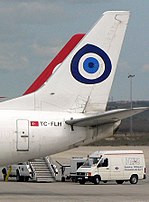| Revision as of 07:56, 18 August 2011 editVerycuriousboy (talk | contribs)470 editsm →See also: 'See Also' links of wiki← Previous edit | Revision as of 11:00, 7 September 2011 edit undo85.65.99.40 (talk) Edit English, Reference TagNext edit → | ||
| Line 1: | Line 1: | ||
| ⚫ | ] | ||
| {{Unreferenced|date=January 2009}} | |||
| ⚫ | ] | ||
| ] | ] | ||
| A '''nazar''' |
A '''nazar''' {{lang-tr|nazar boncuğu}}) is an eye-shaped ] believed to protect against the ] ("evil eye", from ''nazar'' and "amulet" from ''boncuğu''). <ref>''Langenscheidt's Pocket Turkish Dictionary.''Langensheidt, 1992, p. 638. </ref> | ||
| It is |
It is common in ], ], ], ] and ]. In Turkey, the nazar is often hung in offices and homes, or incorporated in jewelery. <ref> ''Lonely Planet Middle East.''Lonely Planet; 6 edition, 2009, p. 559. </ref> | ||
| A typical nazar is made of handmade glass featuring concentric circles or teardrop shapes in dark blue, light blue, white and black, occasionally with a yellow/gold edge. <ref> ''Lonely Planet Middle East.''Lonely Planet; 6 edition, 2009, p. 559. </ref> | |||
| <br style="clear:both" /> <!--NB when the page is fuller this break will probably not be needed--> | |||
| ==Other uses== | ==Other uses== | ||
| The |
The nazar image was used as a ] on the tailfins of aeroplanes belonging to the private Turkish airline ]. It is used in the logo for ], a game engine designed by ], a video game company founded by three Turkish brothers. | ||
| It is used in the logo for ], a game engine designed by ], a video game company founded by three Turkish brothers. | |||
| ==See also== | ==See also== | ||
| Line 26: | Line 22: | ||
| ==References== | ==References== | ||
| {{reflist}} | |||
| {{Refs}} | |||
| <br style="clear:both" /> <!--NB when the page is fuller and the stub tags deleted this break will not be needed--> | |||
| ] | ] | ||
Revision as of 11:00, 7 September 2011


A nazar Template:Lang-tr) is an eye-shaped amulet believed to protect against the evil eye ("evil eye", from nazar and "amulet" from boncuğu).
It is common in Afghanistan, Turkey, Armenia, Iran and Greece. In Turkey, the nazar is often hung in offices and homes, or incorporated in jewelery.
A typical nazar is made of handmade glass featuring concentric circles or teardrop shapes in dark blue, light blue, white and black, occasionally with a yellow/gold edge.
Other uses
The nazar image was used as a symbol on the tailfins of aeroplanes belonging to the private Turkish airline Fly Air. It is used in the logo for CryEngine 3, a game engine designed by Crytek, a video game company founded by three Turkish brothers.
See also
References
- Langenscheidt's Pocket Turkish Dictionary.Langensheidt, 1992, p. 638.
- Lonely Planet Middle East.Lonely Planet; 6 edition, 2009, p. 559.
- Lonely Planet Middle East.Lonely Planet; 6 edition, 2009, p. 559.
This culture-related article is a stub. You can help Misplaced Pages by expanding it. |
This Turkey-related article is a stub. You can help Misplaced Pages by expanding it. |